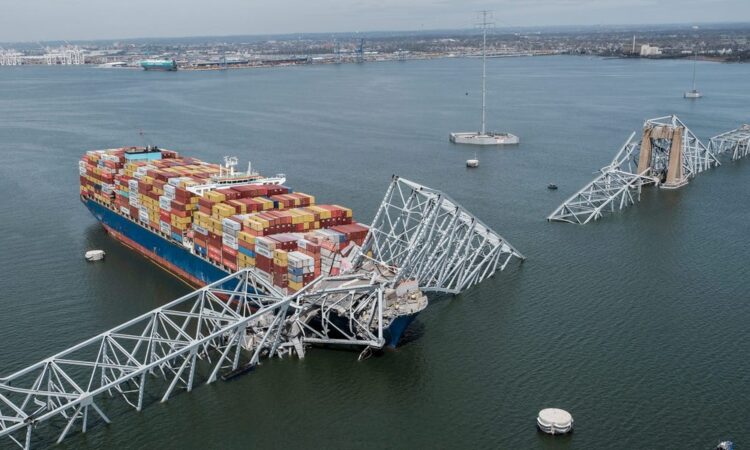
- Economists don’t expect the Baltimore bridge collapse and port closure to have an impact on growth.
- But the disaster is a reminder that the US is vulnerable to supply-chain shocks, experts say.
- Baltimore’s economy is also likely to suffer, they say.
The collapse of the Francis Scott Key Bridge on Tuesday is a reminder that the economy remains vulnerable to sudden supply-chain shocks, experts say.
While the disaster is unlikely to have a tangible effect on headline GDP growth or inflation, it could affect specific sectors, drive up shipping and trucking costs, and affect employment in Baltimore, they say.
The bridge collapsed after the Dali, a Maersk-chartered ship collided with one of its support beams. Six construction workers on the bridge at the time are presumed dead.
Here’s how the catastrophe could affect the economy, trade, and the city of Baltimore.
Economy intact
The bridge’s collapse isn’t expected to have a meaningful impact on the economy, which continues to grow at a surprisingly fast pace despite Wall Street’s longer-term worries about a potential recession.
“This event will have greater economic implications for the Baltimore economy than nationally,” Oxford Economics’ chief US economist Ryan Sweet said on Tuesday in a research note.
“We don’t anticipate that the disruptions to trade or transportation will be visible in US GDP, and the implications for inflation are minimal. There will likely be some temporary disruptions to certain industries, including automakers, but nothing that warrants an immediate change to our baseline forecast,” he added.
JPMorgan also downplayed the potential impact of Tuesday’s disaster, with strategists saying in a research note that they were predicting “minimal implications for vehicle inflation.”
Experts told BI that the port of Baltimore contributes economic activity worth $15 million a day, although Sweet put that figure at just $2 million.
Those might sound like big numbers, but they’re not large enough to make much of a dent on the broader economy. It was worth just under $28 trillion as of April 2023, per estimates by the International Monetary Fund.
Baltimore might bear the brunt of any economic pain, according to Sweet.
“The economic costs will be larger for the Baltimore metro area. Around $80 billion in cargo moves through the port annually, and a partial closure of the port could lead to direct and indirect temporary layoffs,” he said. However, the port accounts for less than 0.5% of the metro area’s daily output.
Supply-chain shocks
Certain types of goods could feel the brunt of the disruption.
The port of Baltimore is the busiest for “roll-on/roll-off” cargo, which includes cars, light trucks, and agricultural and construction equipment. If it stays shut for some time then companies face higher costs by having to reroute goods, according to Michael Tamvakis, a professor at City, University of London’s Bayes Business School.
“It is not clear that the closest alternative port, Norfolk, has the capacity to accommodate the kind and type of cargo going to Baltimore,” he told BI. “It is likely that vessels will be diverted, probably to New York or New Jersey, with some cargo completing journeys via rail and truck.”
Protection and indemnity insurance premiums were also likely to rise, Tamvakis added.
Significant amounts of coal, gypsum, sugar, paper, chocolate, and ice cream also pass through the port each day, and Tuesday’s disaster could also affect the market for these goods.
But the bridge’s collapse is unlikely to cause similar disruption to past supply-chain crises such as the Ever Given blocking the Suez Canal in 2021, according to another City, University of London academic Ioannis Moutzouris.
“While the Dali tragedy has already caused disruption in regional supply chains and specific shipping sectors, as Baltimore is a major US roll on-roll off, container, and coal port, its effects are not expected to be comparable to the Ever Given accident,” he told BI.
“Importantly though, the current accident once again highlights shipping’s and, in turn, trade’s sensitivity to unpredictable events and the need to build resilient supply chains,” Moutzouris added.






